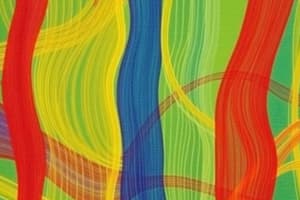Podcast
Questions and Answers
What is the process used to extract silk fibers from cocoons?
What is the process used to extract silk fibers from cocoons?
- Freezing the cocoons to make the silk threads unravel
- Dipping the cocoons into hot water (correct)
- Spraying the cocoons with cold water
- Drying the cocoons under the sun
Which type of silk is characterized by a golden luster and coarser texture compared to mulberry silk?
Which type of silk is characterized by a golden luster and coarser texture compared to mulberry silk?
- Mulberry Silk
- Spider Silk
- Tassar Silk (correct)
- Eri Silk
What is one concern related to the sustainability of sericulture?
What is one concern related to the sustainability of sericulture?
- Minimal demand for silk products
- Overuse of synthetic fibers in production
- Excessive water usage in silk production
- Deforestation for silkworm feeding (correct)
Why is Eri Silk considered an environmentally friendly alternative to mulberry silk?
Why is Eri Silk considered an environmentally friendly alternative to mulberry silk?
How is the silk industry adapting to meet changing consumer and environmental needs?
How is the silk industry adapting to meet changing consumer and environmental needs?
What is the name of the larvae of the Bombyx mori moth used in silk production?
What is the name of the larvae of the Bombyx mori moth used in silk production?
During which stage of their life cycle do silkworms spin their cocoon?
During which stage of their life cycle do silkworms spin their cocoon?
What substance does the silkworm secrete to bind the silk threads together during cocoon formation?
What substance does the silkworm secrete to bind the silk threads together during cocoon formation?
What is the purpose of the outer layer of the silk cocoon?
What is the purpose of the outer layer of the silk cocoon?
After silkworms transform into moths and leave their cocoons, what is the next step in silk production?
After silkworms transform into moths and leave their cocoons, what is the next step in silk production?
Flashcards are hidden until you start studying
Study Notes
Exploring Sericulture: The Art of Silk Production
Sericulture is a centuries-old industry that revolves around the production of silk, a luxurious and versatile natural fiber. This article delves into the fascinating world of sericulture, highlighting the key aspects of silk production.
Silkworms and Their Life Cycle
The process begins with silkworms, the larvae of the Bombyx mori moth. These caterpillars feed on mulberry leaves and undergo a remarkable transformation during their life cycle. After feeding on leaves for several weeks, the silkworms enter a stage called the pupal stage. During this stage, the silkworm spins its cocoon, consisting of a single continuous filament of silk. In the cocoon, the silkworm metamorphoses into a moth.
The Process of Cocoon Formation
The cocoon-forming process is essential to the production of silk. When the silkworm finishes feeding, it secretes a type of glue which it uses to bind the silk threads together. The silkworm starts by spinning a loose nest around itself and gradually builds the cocoon. The resulting silk structure is made up of two layers: the outer layer is tough and serves as a barrier against predators, while the inner layer is smooth and provides the silk threads for harvesting.
Unraveling and Processing Silk
After the silkworms have transformed into moths and left their cocoons, the cocoons are collected and prepared for unraveling. To extract the silk fibers, the cocoons are dipped into hot water, which causes the silk threads to unwind and unravel. The two layers of silk are separated by hand, resulting in a continuous thread of raw silk.
Varieties of Silk
The silk industry produces several types of silk, each with unique characteristics.
- Mulberry Silk: This is the most common type of silk, derived from the Bombyx mori silkworm. It is characterized by its smooth texture and strong fibers.
- Tassar Silk: Produced by the Antheraea mylitta moth, Tassar silk has a golden luster and is coarser than mulberry silk.
- Eri Silk: Derived from the Philosamia ricini moth, Eri silk is an ecologically friendly alternative to mulberry silk because it does not require mulberry leaves for feeding.
Sericulture and Sustainability
Sericulture is a mostly sustainable industry, but there are concerns about the use of pesticides and deforestation to provide food for silkworms. Researchers are developing new practices and alternative feed sources to make silk production more environmentally friendly. For instance, using agricultural waste as feed or planting mulberry trees in areas where silkworms are raised could reduce the industry's ecological footprint.
The Future of Sericulture
Sericulture has faced challenges in recent years, including competition from synthetic fibers and declining demand for silk. However, the industry is evolving to meet the changing needs of consumers and the environment. Sericulture is embracing innovative techniques, such as sericin extraction, silk blending, and the development of new silk products. By exploring new applications for silk and adopting sustainable practices, sericulture will ensure its longevity and the continuation of this ancient art.
In conclusion, sericulture is an intriguing and significant industry that relies on the remarkable life cycle of silkworms and the unique properties of silk. From the transformation of silkworms into moths to the extraction of silk fibers, sericulture is a complex and fascinating process that has been perfected over thousands of years. As the world continues to explore new applications for silk and adopt sustainable practices, the future of sericulture looks promising.
Studying That Suits You
Use AI to generate personalized quizzes and flashcards to suit your learning preferences.




